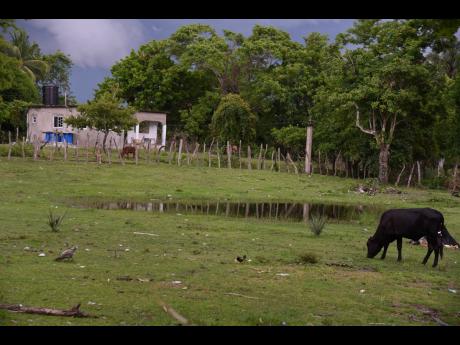Frog fright grips Slipe
Residents of St Elizabeth district hopping mad as uninvited guests spark panic
Residents of Slipe in St Elizabeth are grappling with an unsettling and unfamiliar amphibian invasion.
Over the past year, locals have reported an influx of a new frog species that is not only visually distinct – varying from white to green – but also notably invasive. The presence of these frogs has become a significant source of distress for the community, particularly due to their nocturnal habits.
Speaking with The Gleaner last Thursday, some residents shared their fear of the creatures.
“Mi nearly have heart attack,” one woman said, noting one encounter with one of the frogs.
She and others noted that the critters were mostly active at night, entering their homes and causing a nuisance.
“Dem all jump pon we inna we bed and you haffi fling off you sheet! Mi nuh love dem at all. Dem something deh no nice at all,” the woman said.
The resident added that her fear often prevents her from sleeping, as she has had the unsettling experience of the frogs jumping on her too many times.
“When you take your phone light and a try find dem, you can never find dem after,” she stated, adding that the frogs also scare the children.
Juliet Adair informed The Gleaner that the frogs predominantly inhabit trees and, at night, make their way into homes where they can be found on walls and ceilings.
“The original bullfrog dem stay on the ground, but dem [new ones] nah stay a nuh ground. Dem mostly stay inna tree, and if you have your drum with water, dem go inna di water,” she explained.
BIRD FOOD
One man said that the frogs have three-inch bodies, long legs, and sticky feet.
“I don’t know if anything can be done about dem, but I noticed that the birds eat dem. You have some predator birds like the crow and some other birds that eat them,” he said.
The issue was raised at the monthly meeting of the St Elizabeth Municipal Corporation last week by Dwight Salmon, councillor of the Black River division. He stated that the frog infestation is “of great concern” and that he was seeking assistance from the relevant authorities to address the problem.
Karl Whyte, councillor of the Pedro Plains division, said that the National Environment and Planning Agency (NEPA) was aware of the situation.
CUBAN TREE FROGS
He said the creatures are believed to be the invasive Cuban tree frogs ( Osteopilus septentrionalis), whose presence has also been noted in other parishes.
“NEPA has gotten reports. There were reports up to last week ... . It is a concern, and I know that NEPA is aware, and I think that there’s some local campaign being put together to sensitise residents about them,” he added.
The invasive Cuban tree frog was first identified in Jamaica around 2018. Originally from Cuba, this species has also spread to the Cayman Islands, Florida, and The Bahamas.
As a defence mechanism, these frogs secrete a mucus that can irritate the skin, eyes, and nose, and in some cases, even trigger asthma.
In response to earlier infestations affecting the parishes of St Catherine, Clarendon, Manchester, and St Elizabeth, NEPA advised residents to capture the frogs using a bag and then freeze them to euthanise them safely. They also recommended reducing standing water in communities to limit breeding sites.
This advice poses a particular challenge for Slipe, where many homes are built on swampy land and large areas of stagnant water remain prevalent.
“According to NEPA, they’re not poisonous and stuff like that, but it is a concern, and I’m sure we’ll hear more about it coming from the relevant agencies,” Whyte said.




